2.2 Exercise 2: Searching in the public domain
xtine burrough and Michael Mandiberg
Just because you can download an image doesn’t mean you can use it! An image may be protected by copyright laws. Similar to a patent, a copyright is a legal tool for preserving control over the use of a creative work. Books, poems, music recordings and compositions, photographs, paintings, sculptures, radio and television broadcasts, films and even dances can be copyrighted. The Artist Formerly Known As Prince even has his symbolic name, “Love Symbol #2” protected by copyright law.
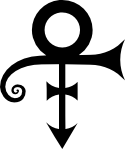
England initiated the copyright laws familiar to today’s citizens as the Statute of Anne (1709). By the 1700s, the widespread use of the printing press and an increase in literacy rates resulted in printers commonly reprinting texts without crediting their rightful authors, or paying them. The Statute of Anne gave the author the exclusive right to a work for a fixed period of time.
Copyright durations vary by nation. In the United States the length of a copyright used to be the life of an author plus 50 years; on the 50th year after the death of an author, their works would be released into the public domain. For works created by corporations, the length was 75 years from the date of publication. In 1998 congress passed the Sonny Bono Copyright Term Extension Act, which extended copyright by 20 years. This law was authored by a musical-entertainer-turned-Congressman, and was heavily lobbied by the media industry. The act became known as the “Mickey Mouse Protection Act,” as Disney lobbied extensively to insure that the law reached back just far enough to protect their copyright over Mickey Mouse.
Public Domain images have no licensing restrictions. An image automatically enters the Public Domain when a copyright expires. Public domain is currently under attack, as media corporations struggle to control their monopolies. The irony is that copyright was introduced to protect authors from this type of monopolistic power.
An image is protected by copyright unless:
- the use qualifies as “fair use”
- the author declares it is part of the public domain
- the image is old enough that the copyright has expired
- the author licenses it under an alternative model
Several alternative licensing models exist, the most popular of which is a Creative Commons license. Creative Commons operates under the moniker “Some rights reserved” and offers a range of licenses with subtle degrees of control over whether derivative works and for-profit uses are allowed. Wikimedia Commons (http://commons.wikimedia.org), and Flickr (http://flickr.com/creativecommons) focus partially or exclusively on public domain or Creative Commons licensed images.
Wikimedia Commons is an archive of Public Domain and Creative Commons images. Much like Wikipedia it is organized by historical subjects, and is collectively edited and maintained.
![]()
CC-By-NC-SA, Creative Commons Licensing icon
- Go to the Wikimedia Commons (http://commons.wikimedia.org) and search for Walter Gropius, the founding director of the Bauhaus.

Wikimedia Commons home page at http://commons.wikimedia.org - View several of the images, and notice in the information below the image states the images are either Public Domain or licensed Creative Commons.
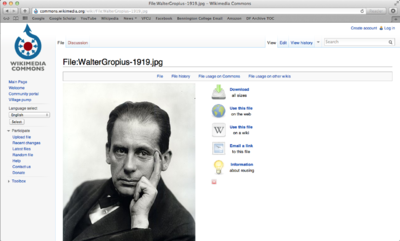
The search return for Walter Gropius, founder of Bauhaus 
Wikimedia image rights and information - Flickr is a photo sharing site that encourages the culture of sharing through many of its features, and many Flickr users license their photographs under Creative Commons. Go to Flickr (http://flickr.com), click on the magnifying glass next in the search bar, and then click on Advanced Search.
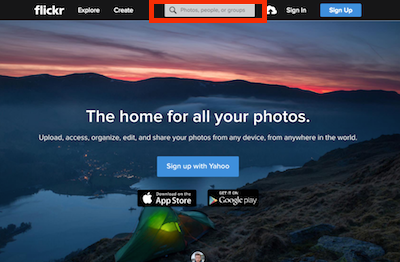
Flickr photosharing (homepage) https://www.flickr.com/ - Type in Bauhaus, and select from the ‘Any license’ drop-down menu “All Creative Commons” Everything in your search should be CC licensed, though not all will allow derivative works (for example, using the image in a collage) or commercial use.
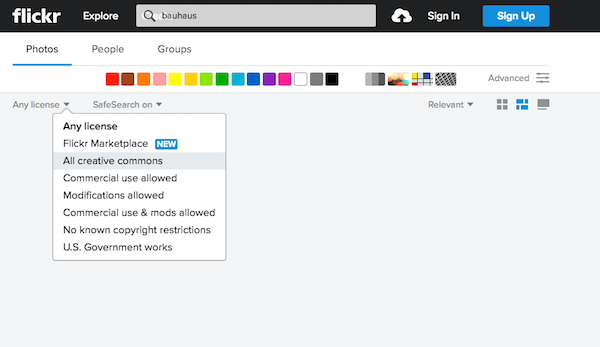
Flickr search engine. Start your search by typing in your subject in the search field located by the magnifying glass and then choose “All creative commons”
Licensing your work
Licensing work with a Creative Commons (CC) license is easy.
Upon setting a Creative Commons license, the creator of the work decides if both commercial and noncommercial uses are allowed (some are noncommercial only), if others are allowed to modify the work once it is licensed (called, “derivative work”), and if derivative works are allowed, whether or not the newly modified work also has to be licensed with CC (called, “share alike”).
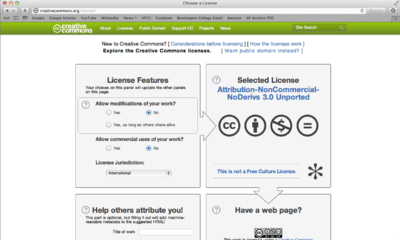
The types of licenses and a very brief description of each follows. Usually more than one type of licensing is in use. More information can be found on CreativeCommons.org. All CC licenses state that the original author will be given credited for her work, in addition to the following details:
| Icon | Right | Description |
|---|---|---|
| Attribution (BY) | Licensees may copy, distribute, display and perform the work and make derivative works and remixes based on it only if they give the author or licensor the credits (attribution) in the manner specified by these. | |
| Share-alike (SA) | Licensees may distribute derivative works only under a license identical (“not more restrictive”) to the license that governs the original work. (See also copyleft.) Without share-alike, derivative works might be sublicensed with compatible but more restrictive license clauses, e.g. CC BY to CC BY-NC.) | |
| Non-commercial (NC) | Licensees may copy, distribute, display, and perform the work and make derivative works and remixes based on it only for non-commercial purposes. | |
| No Derivative Works (ND) | Licensees may copy, distribute, display and perform only verbatim copies of the work, not derivative works and remixes based on it. |
Fair use and appropriation
Fair use
Reproducibility is a principal trait of digital media. Unlike paintings, records, books, videotapes or even photographs, an exact replica of digital media can be made from the original file. This is true for digital photographs, Compact Discs (and MP3s), DVDs, and websites. From sampling to mashups, collage to subvertisements, contemporary artists and content creators use digital files as source material for the derivation of new works. These works are considered new and original, but they are sometimes built with bits and parts of copyrighted works. In the digital age, new works are often created when more than one existing work is recombined in a new way, providing new visual relationships and new ideas.
Copyright content can be used in a new work as long as permission is obtained from the copyright holder, or if the media use falls into the category of fair use. Under the fair use clause of copyright law, limited copyrighted material can be used for a “transformative” purpose, such as commenting upon, criticizing or parodying the initial material. The 4 key factors are
- the purpose of the derivative work
- the nature of the original work: was the original mostly factual or creative
- the amount of original work used
- the effect that the new work has on the potential or actual market value of the original
Weighing these four factors in a copyright case is not an easy task, which is why judges have been asked to do so. However, successful commercial media that takes advantage of the fair use clause include Saturday Night Live skits, The Simpsons cartoons and Weird Al Yankovic songs.

Caption: 60X1, Kenneth Tinkin-Hung, date?. This net art parody is protected by the fair use clause of the United States copyright laws.
Appropriation
Appropriation is a word that is used by media artists to describe the visual or rhetorical action of taking over the meaning of something that is already known, by way of visual reference. For example, Andy Warhol appropriated the Campbell’s soup can visual identity to make large, iconic silkscreen prints of the face of Campbell’s soup cans. Warhol’s soup cans are a modified version of “the real thing.” The visual reference to the original soup can is important, as the viewer needs this information in order to understand the idea that the reference conveys (your personal translation of this could be something as simple as a popular American icon to a feeling associated with comfort food). By transforming not only the size and limited graphic palette for portraying the soup cans, but also the place where the viewer will encounter them (an art gallery as opposed to the grocery market), Warhol appropriates the original Campbell’s soup cans to create American art that relates to popular culture in its iconic form. Appropriation falls into the category of fair use.
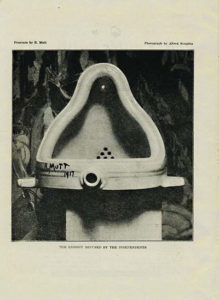
Marcel Duchamp was the first artist to appropriate a common object in his art. This challenged the art community in its definition of what is or is not labeled, “art”. His ready-made sculpture was a urinal transformed into a sculpture because Duchamp signed his pseudonym, R. Mutt on the urinal and submitted it to an art exhibit. Duchamp believed that when an artist declared an object a work of art, the object truly becomes art. In this act of appropriation, the everyday object becomes something other than what it once was. In the case of the urinal, the transformation included the addition of the signature to the porcelain, the change of location (from a bathroom to a gallery), and the change in purpose (whereas before the urinal entered Duchamp’s hands this may have been untrue, after 1917 no one has used the urinal that R. Mutt has signed for the purpose of waste containment).
There is no file to save for this exercise.

